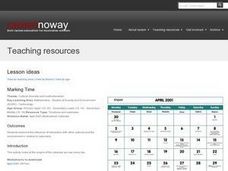Curated OER
Turkeys and Feathers
Students play a game of tag while holding the position of turkey or feather. The turkey's are it and when they catch a feather they switch positions. Great for Thanksgiving.
Curated OER
Go Fish!
Students are introduced to the culture of the Kumeyaay. Using their text, they discover how they used their native flora and fauna in San Diego. They participate in a matching game and examine the types of organisms who make their home...
Curated OER
Climate Watch
Pupils participate in a national survey of biological indicators of climate change by gathering and submitting data on local plants and animals.
Curated OER
Credit: Taking an Interest in Credit
Students examine how credit works but looking at how credit cards and interest rates work. They use percentages to solve problems using credit card interest rates while completing a worksheets.
Curated OER
Client Profiles
Students collaborate in a group setting while determining the specific housing needs of their "clients". Once the needs have been addressed, they find a floor plan that meets those needs and create a presentation outlining how the floor...
Curated OER
Comparing Matter
Students use Internet to research and discover states of matter and explain how molecules are arranged in each state, complete Comparing Matter Work Sheet, and identify objects around classroom that fit three states of matter definitions.
Curated OER
Heart Rate Monitor 1K
Pupils practice moving at an appropriate pace to maintain a target heart rate.
Curated OER
Amphipod Ecology
Learners count amphipods under kelp wracks of varying ages to explain how long it takes for them to find their food source. They collect and represent the data.
Curated OER
Creature Tag
First graders play a version of tag. They come out of the designated safe area when the teacher calls out a signal. They move to a new safe area when another signal is called out. A tagger is performing the same action while trying to...
Curated OER
What's Bright Red and Invisible?
Students study that very little sunlight penetrates the ocean below depths of 200 meters. They study that no light penetrates the ocean below depths of 1000 meters. They study that the quality of light changes as depth increase
Curated OER
Water Density Boundaries
Students create observable layers in water that represent a separation based upon density differences. They model density boundaries using differences in temperature and salinity. They, in groups, perform a meaningful experiment...
Curated OER
Hands of Doom
Students discuss the four essential step used for safe food handling: clean, separate, cook, and chill. They identify the bacteria that can cause food poisoning, practice how to properly wash hands before and after handling food,...
Curated OER
Paper Tower Challenge
Student explore the challenge of building a tower using paper. They build their tower using paper and record the height of their tower. Students collect and record the heights of other towers and use that data to create a spreadsheet.
Curated OER
A Sore Sight for Eyes
Students consider 'visual blights', including technology-related ones, in their communities.
Curated OER
About to Explode
Young scholars explore Mount St. Helens' quiet eruption of 2004-2005. They examine different types of eruptions and then present creative first-hand accounts of different volcanic eruptions in history.
Curated OER
Hospital Tag
Students participate in a game of tag in which they must perform a variety of activities to be unfrozen after being tagged. They use a variety of locomotor skills while moving around the play area.
Curated OER
Using SWMP Data
Students are introduced to the SWMP system which tracks short-and long-term changes in water. Using this data, they plot and interpret the data on a graph to determine how human activities are lowering the water quality. They also...
Curated OER
Participants are challenged to create several different sorting groups for the set of images.
Learners examine the influence of interaction with other cultures and the environment in relation to calendars. They also look at the origins of the calendar we use every day.
Curated OER
Mapping My Community
Ninth graders are introduced to GPS technology. They complete fieldwork as they visit a specific area of their community to identify and map types of land use in the surveyed area. They use the collected data to create a digital map.
Curated OER
Barriers to Change: The Myths about Vehicle Idling
Students have the opportunity to confront some of the most common misconceptions that surround vehicle idling, and employ the concept of social marketing to initiate change. The goal is to give students an appreciation of the impact of...
Curated OER
Who Invented It? When? Chinese Inventions: An Introductory Activity
Students use Robert Temple's "The Genius of Chins: 3,000 Years of Science, Discovery and Invention", to understand how much the Chinese have contributed with their scientific and technological ability.
Curated OER
Bones and Muscles
Third graders are introduced to bones as the body's means of support and protection. They research bone facts and conduct an experiment with chicken bones. They identify and observe involuntary muscles at work.
Curated OER
Seed Selection for Genetic Variation
Students will research the origin of corn, analyze factors that contribute to shorter and longer growing seasons, and use the scientific method to answer the question: Did seed selection contribute to the successful movement of corn from...
Curated OER
Speedball
Learners work as a team in a game of Speedball. They are taught to value the benefits of physical activity as they investigate a new sport. Students successfully participate in a game of Speedball after participating in a drill that...

























